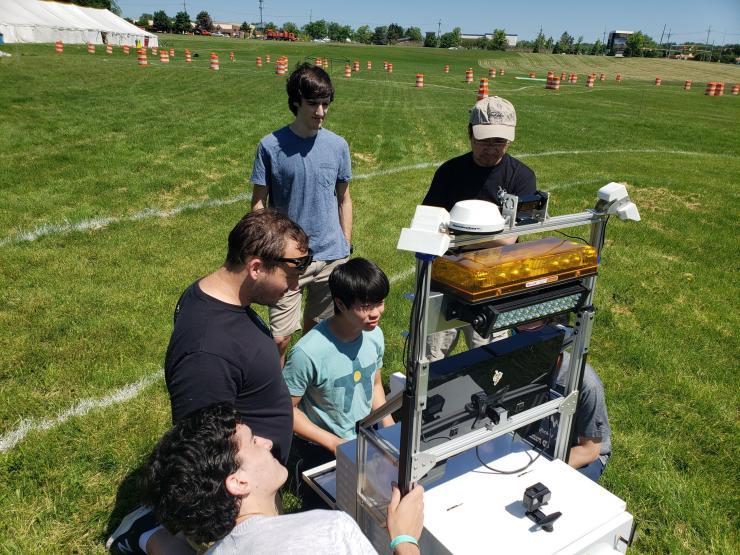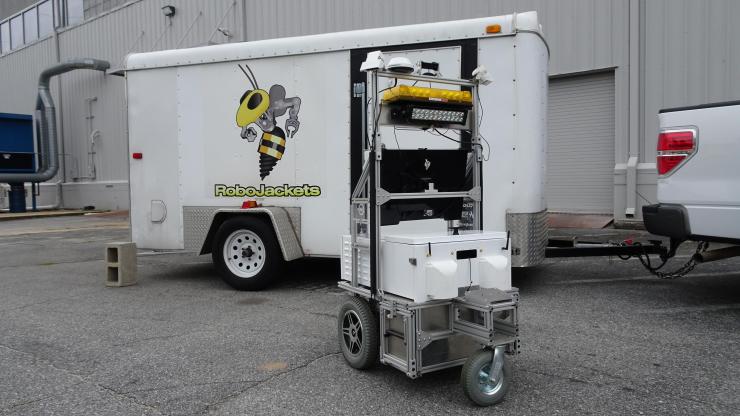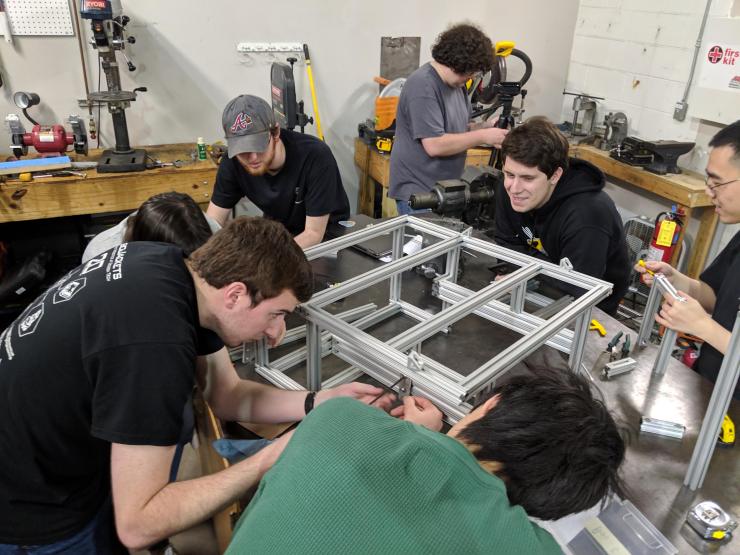RoboJackets Achieve Highest IGVC Finish in Team History
Jul 17, 2019 — Atlanta, GA

The RoboJackets' IGVC software team members test their code on the course. (Credit: RoboJackets)
This summer, Georgia Tech’s competitive robotics organization, RoboJackets, participated in the 27th annual Intelligent Ground Vehicle Competition (IGVC) at Oakland University in Rochester, Michigan. The focus of the competition was to design and build an autonomous robot capable of completing an outdoor obstacle course.
RoboJackets has competed in IGVC since 2003, but this year they had the best performance in team history, winning the Dr. William G. Agnew Award for first place in the design competition and the Paul Lescoe Award for third place overall.
The teams are judged on how far they are able to navigate the Auto-Nav Challenge (short for autonomous navigation) obstacle course and how well they defend their robotic design decisions. Georgia Tech earned 430 out of 480 possible points for their design, awarded by a panel of nine judges.
The IGVC team is one of four within the RoboJackets organization. Its members are primarily focused on developing a software strategy for detecting and navigating around obstacles, though they also do extensive work on the chassis and electronics of the robot itself.
This year, they built a robot called Jessii from scratch, working in software, mechanical, and electrical teams to enhance every aspect of the technology and design. The name “Jessii” is a tribute to the team’s previous robot, Woodi, named for its wooden construction. Jessii was based on Woodi’s design and became the team’s “new toy,” much like Woody and Jessie in the movie Toy Story 2.
Each year, the software team uses research-level algorithms and state-of-the-art machine learning techniques in developing the final product. Implementing these software concepts in a realistic, dynamic setting is what the team considers both challenging and rewarding about IGVC. Successfully executing such a complex code base enhances their teamwork, communication, and planning skills and allows them to explore cutting-edge algorithms that are not taught in the classroom — and to see how this new knowledge works in a competitive environment.
To support the software used in Jessii’s autonomous navigation, the IGVC mechanical team custom-built a platform for the sensors and other electronics. Jessii’s base was built out of 8020 aluminum framing, providing a sturdy foundation to hold everything she needed to work her way through the obstacle course.
The electrical team designed custom-printed circuit boards to handle motor control and an emergency stop system for the robot, as well as a system to distribute power to all necessary components. Notable electrical innovations included the implementation of a custom Ethernet communication protocol and bringing hotswap capability to the custom computer.
In the coming year, the team hopes to build on Jessii’s successful design while also looking to new sources of inspiration. After Jessiii, the next iteration, is brought to life, the RoboJackets plan to create a completely new robot.
“At the end of the day, we’re a club that exists to help our members learn more and have fun. By building a brand new robot, everyone can feel more involved and participate in important and exciting design decisions,” said Cameron Loyd, RoboJackets IGVC project manager.
Learn more about IGVC and other RoboJackets competitive teams at www.robojackets.org.

The RoboJackets team at IGVC 2019 (Credit: RoboJackets)

The RoboJackets' IGVC robot for 2019, Jessii (Credit: RoboJackets)

The RoboJackets' IGVC mechanical team during their annual build-a-thon. (Credit: RoboJackets)
Institute Communications




